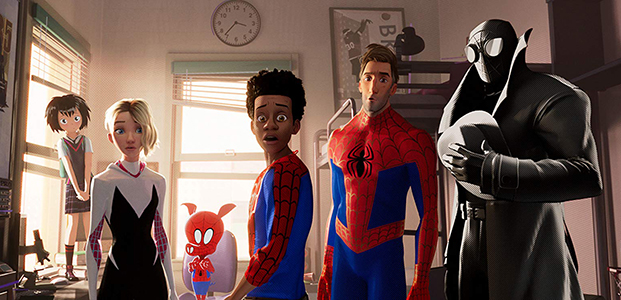
Spider-man: Into the Spiderverse performs a minor miracle. It makes the character of Spiderman, perhaps the most repeatedly re-adapted comic book character of the past decade, seen countless times and in numerous screen incarnations, feel fresh and invigorating.
The decision to shift the focus from Peter Parker to teenager Miles Morales, an alternative universe version of Spiderman first introduced in the Ultimates imprint of Marvel comics, is the key differentiator, but so is the smart move to present this in animated form. The latter allows us to experience the world of Spiderman like never before – an exhilarating cornucopia of action animation that looks psychedelic but never frenzied.
The story is both familiar and novel. Morales is bitten by a radioactive spider, yes, but that’s where the similarities end. He has caring parents and a wayward uncle he looks up to, but the spiraling of his life out of his control in the dramatic fashion of adolescence is marvelously depicted, with the confusion of growing pains heightened by abilities that he doesn’t completely understand. What complicates the situation is a seismic inter-dimensional shift, caused by a lab experiment that’s wrecked by superhero battle, which results in multiple embodiments of Spidermen (male, female, anime, retro, and even swine) crashing into Miles’ world.
That last bit is especially noteworthy because like a Pixar film (think the cerebral Inside Out), Spiderverse confidently and boldly dares to take a concept that kids would usually find alienating, even confounding i.e. parallel universes, and embeds it into the core of the storytelling in ways that are ingenious, fun and easy to follow without being confusing. Another big reason why the viewing experience is so rewarding is because the film comes across as entirely standalone. If you don’t know Spiderman it completely works. If you do and have read every comic, including the Brian Michael Bendis run that inspired this, its still doozy. There is no sequel setup, prequel teasing or breadcrumbs for later trilogies.
I’ve already alluded to how the animation is just one factor in the films winning formula, but it really is indescribably distinctive, seemingly able to fully exploit the potential of the medium. Presented as a combinationµ of what looks like hand-drawn characters (it emulates the penciling of Miles Morales co-creator Sara Pichelli, amongst others) inhabiting a visual world made up of comic book panels and splash pages, the vibrancy of the visuals, with its oceans of colours, offers a seductive new way to present and view comic book based movies. If that isn’t enough, the film’s tone complements its hyperkinetic look, being energetically urban, almost hip with amusing moments of self-referencing (and self-deprecation) that provides laughter and engagement for both movie and comic book fans.
All of this must sound like bad news to those who feel movies based on comic books have reached their apex, overstayed their welcome and exhausted their potential. Sorry to burst your bubbles naysayers – Into the Spiderverse just proves to be a timely antithesis to this view.
Rating: 



